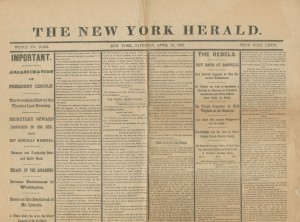 In the 22 January 2014 issue of NEHGS’ Weekly Genealogist, a ‘story of interest’ highlighted the sad plight of 17,000 square feet of old newspapers held by the New York State Library in Albany. Faced with the demand to archive an increasing amount of education department paperwork, the article – “State Library's Tough Calls on What to Save, What to Shred” – illustrated how once treasured collections are now losing the battle for available storage space.
In the 22 January 2014 issue of NEHGS’ Weekly Genealogist, a ‘story of interest’ highlighted the sad plight of 17,000 square feet of old newspapers held by the New York State Library in Albany. Faced with the demand to archive an increasing amount of education department paperwork, the article – “State Library's Tough Calls on What to Save, What to Shred” – illustrated how once treasured collections are now losing the battle for available storage space.
For those who do family research in New York, where the recording of vital records was not instituted state-wide until 1880, the possible loss of alternative sources for researching birth, marriage, and death notices was troubling. It was slightly less depressing to read that only the newspapers from outside New York State were in danger of being recycled – unless libraries or archives stepped in to save them. With any luck, the media interest generated by the article served as a calling card to institutions willing to take over the stewardship of these collections.
To underscore a dedication to safeguarding historic newspapers, the article noted how the State Library spent nearly two decades on a special project to preserve New York State newspapers. With funding from the National Endowment of the Humanities, over 10,500 newspapers from around the state were located, cataloged, and microfilmed between 1987 and 2007. (Click on the image below to expand it.)
Those who make pilgrimages to Albany, either with the annual NEHGS Research Tour or on personal quests for family records, have discovered how valuable this microfilm collection is as a substitute for vital records. Fortunately, researchers don’t need to visit Albany in person to take advantage of this microfilm repository. The New York State Newspaper Project makes this resource available to patrons of other libraries through inter-library loan, though the State Library does charge a fee for filling out-of-state and foreign loan requests.
Anyone who has searched through boxes of microfilm looking for one small death notice has wished for a name index to speed up the process, but these are rarely created. Several years ago, the Northern New York Library Network did the next best thing by scanning the microfilmed newspapers, then processing the digital images through optical character recognition (OCR) software to make the text searchable. Initially, this was done just for newspapers from Clinton, Essex, Franklin, Jefferson, Lewis, Oswego, and St. Lawrence counties. The Network has now expanded the project to include 160 newspapers from twenty New York counties and it recently launched a new NYS Historic Newspapers website. The former Northern New York Historical Newspapers website has been taken offline. Visitors to the old site will be automatically redirected to nyshistoricnewspapers.org. Research and downloading images can be done at no cost.
One must not overlook the work of Tom Tryniski, whose Old Fulton Post New York Post Cards website offers free searching of many New York historical newspapers. Since he began this volunteer project six years ago, Tom has personally scanned and created over 26 million text-searchable pages.
A handy summary of all the websites offering free access to New York newspapers can be found at New York Online Historical Newspapers, listed by county, with links to the NYS Historic Newspapers, Old Fulton New York Post Cards, and many more.
For more information on the 2014 NEHGS Research Tour in Albany, please visit http://www.americanancestors.org/Event.aspx?id=29447.
Share this:
About Helen Herzer
Helen Herzer is the NEHGS Volunteer Coordinator. She oversees NEHGS volunteers providing assistance to the staff on various projects. She is at 101 Newbury Street three days a week, usually on Tuesday, Wednesday, and Thursday. Born in Danbury, Connecticut and raised on the north shore of Long Island, Helen was drawn to the Boston area to attend Harvard College. A long-time member who continues to research her own family lines emanating from upstate New York, she makes frequent pilgrimages to the Albany area in search of records.View all posts by Helen Herzer →
